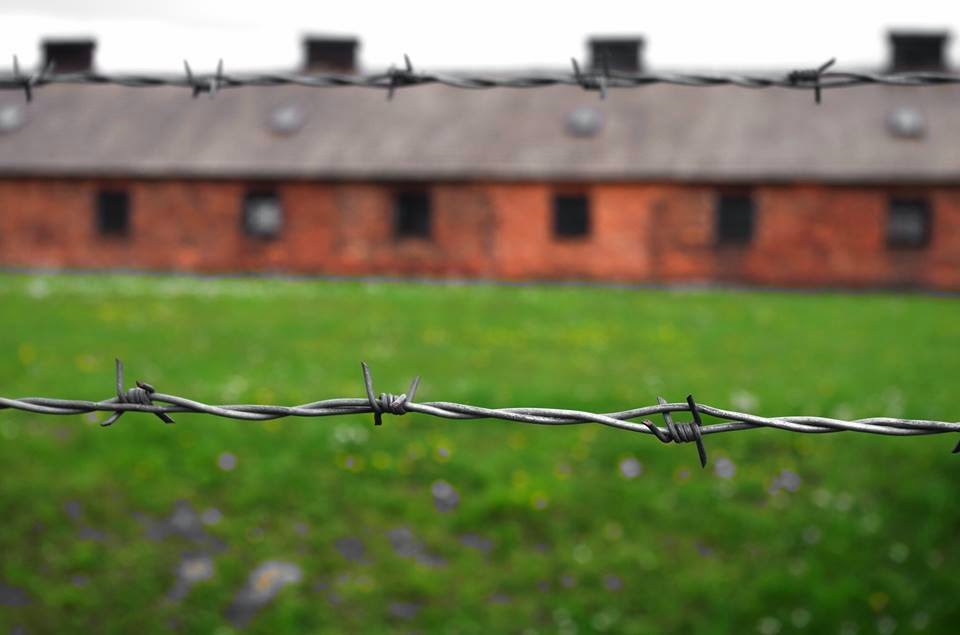Following on from my previous Blog entry, our tour continued 3km away at Auschwitz -Birkenau. (Auschwitz II) This camp became a major site of the Nazi "Final Solution to the Jewish Question". The real horror took place here in Birkenau. Prisoners were murdered in 4 large gas chambers and then incinerated in the crematoria. About 90% of the victims of Auschwitz Concentration Camp died in Birkenau. The majority, more than nine out of every ten, were Jews. A large proportion of the more than 70 thousand Poles who died or were killed in the Auschwitz complex perished in Birkenau. So did approximately 20 thousand Gypsies, in addition to Soviet POWs and prisoners of other nationalities, Jehovah's witnesses and homosexuals.
"The direct reason for the establishment of the
camp was the fact that mass arrests of Poles were increasing beyond the
capacity of existing "local" prisons. Initially, Auschwitz was to be
one more concentration camp of the type that the Nazis had been setting up
since the early 1930s. It functioned in this role throughout its existence,
even when, beginning in 1942, it also became the largest of the death
camps". (From the Auschwitz website)
This was part 2 of our tour of Auschwitz. This camp is more derelict than Auschwitz I. It is also much larger - covering a vast amount of land.(470 acres) We entered through the famous archway in the main tower block.
Controversy surrounds the Allied Powers' refusal to believe early reports of atrocities at the camp, resulting in their failure to bomb the camp and its railways. Indeed, the deception was able to take place, initially, as locals within a 10km radius were forced to leave their homes, effectively making the camp a place in the middle of nowhere.
Leading from the main tower outwards, are the bare train tracks. A strong, silent reminder of the million prisoners who were transported here from all over Europe.
Right at the end of the tracks is a simple wire sculpture, depicting a male and female. It is to commemorate Holocaust Memorial Day, which falls on 27th January, the date of the liberation of Auschwitz.
The decision was made in 1941 to locate mass
extermination facilities next to the camp that was under construction in
Birkenau—gas chambers for the mass killing of Jews brought to Birkenau as part
of the Third Reich leadership’s plans for the complete extermination of the
Jews of Europe. These gas chambers went into operation the following
year.
It is here, at the end of the tracks were the remains of the gas chambers are situated. The SS bombed the four gas chambers immediately on discovery in an attempt to try to cover up the atrocities committed there. They remain as they were after bombing. The blueprints for the design of the gas chambers were discovered as the Nazis did not time to burn all the paperwork and so accurate models of the gas chambers have been made and are housed in Auschwitz I.
Close by are small ponds were human remains were often hidden. A solitary red rose lay placed there on the day that we visited. Our guide informed us that during the summer, when the pond dried up, human bones could be seen, sticking out of the remaining mud.
We went on to some of the remaining barracks.
Two
types of barracks, brick and wooden, housed prisoners in the Birkenau Camp. The brick barracks stood in the oldest part of the camp, known
as sector BI, where construction began in the Autumn of 1941. Inside each of them
were 60 brick partitions with three tiers, making a total of 180 sleeping
places, designed to accommodate 4 prisoners. The SS envisioned a capacity of
over 700 prisoners per block. At first, the buildings had earthen floors but over
time, these were covered with a layer of bricks lying flat, or with a thin
layer of poured concrete. The barracks were unheated in the winter. Two iron
stoves were indeed installed, but these were insufficient to heat the entire
space. Nor were there any sanitary facilities in the barracks. Only in 1944
were sinks and toilets installed in a small area inside each block.
Here on one of the bunks lies some wildflowers that a visitor has left in remembrance of the prisoners.
The barracks have been supported by wooden beams as they had started to sink.
The perimeter fencing remains. It would have been double-electrified. Escape would have been almost impossible. Some did escape and survive, but very few.
The road running parallel to the camp.
This truly is one of the most interesting but moving places that I have ever visited. Words and pictures just don't do it justice.




























No comments:
Post a Comment